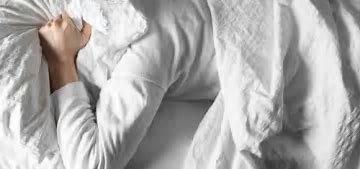You know when you feel sleepy. You may even describe
yourself as tired all the time. But regular sleepiness can tip over into
something far more dangerous if you have a condition called obstructive sleep
apnoea.

We all have the occasional poor night’s sleep, waking up
feeling sluggish and tired. During the day we may lack energy, find it hard to
concentrate or notice a low mood. But people who have obstructive sleep apnoea
(OSA) can experience these feelings every day.
Nearly one billion people globally have OSA, making it one
of the most common sleep disorders. The health and financial costs are high.
According to Australia’s Sleep Health Foundation, OSA not only disturbs your
sleep, it’s a stress on your body.
There is strong evidence that people with untreated moderate
to severe OSA have other health problems, says the Sleep Health Foundation.
These include increased risk of high blood pressure, heart attack, stroke,
diabetes, and depression. Thinking is less clear, mood is affected, and
productivity at work and at home suffer. OSA also increases the risk of motor
vehicle and workplace accidents by six to seven times.
With a recent study in the Lancet estimating almost
one billion people are affected by sleep apnoea, it is not hard to imagine that
the financial costs associated with this are high, including health care costs,
lost productivity and other financial impacts.
What is OSA?
OSA is more than just bad snoring. If you have OSA the walls
of your throat relax and narrow during sleep, interrupting normal breathing.
Your airway can partially or completely close, which means your breathing often
stops for a short time, even for up to a minute. You’ll wake for a few seconds
to open your airway, perhaps snort and gasp, then drift back to sleep again,
often without realising you’ve woken up. This can happen hundreds of times a
night. OSA is classified as mild, moderate or severe depending on how many
times your sleep is interrupted during an hour.
What are the signs of OSA?
Loud snoring is a very common symptom of OSA (so loud your
bed partner might complain that it’s intolerable), as is waking during the
night choking or gasping for air. You may wake in the morning feeling
unrefreshed, experience morning headaches, a dry mouth or a sore throat.
Daytime tiredness is common, as is difficulty concentrating, and you may notice
your work quality suffering as you experience reduced alertness.

Your mood can be affected when you have OSA – it’s common to
feel more irritable, depressed and anxious after unrefreshing sleep, and to
lose your sex drive. Rapid weight gain or difficulty losing weight can also
result from untreated OSA. But these symptoms can come and go, and many people
remain unaware that they have the condition, or don’t realise that it is
serious.
Who gets OSA?
While OSA mainly affects men, women can have it too,
particularly after menopause. OSA was reportedly a contributing factor behind
the death of actress Carrie Fisher in 2016. Sleep apnoea can even affect
children. Aside from being male, there are other factors that increase your
risk, including:
- Being overweight, in particular
having excess fatty tissue around the neck, which can cause a narrowing of the
throat. However OSA can also occur in people who aren’t overweight.
- Having a large neck circumference
(>43cm for men; >40cm for women).
- Being middle aged and older.
- Smoking – smokers are three times
more likely to have sleep apnoea than non-smokers.
- Excess alcohol consumption,
particularly at night. Alcohol can relax the muscles in your throat, closing
the upper airway. Sleeping pills can have a similar effect.
First, get a diagnosis
Don’t attempt to self-diagnose sleep apnoea. First see your
doctor, who can refer you to a sleep specialist if necessary, who may recommend
a sleep study. That way you’ll find out if you have sleep apnoea, whether it’s
mild, moderate or severe, and what treatment would be most appropriate for you.
What you can do to reduce your risk
According to the Sleep Health Foundation, for people with a
mild level of OSA and few symptoms, losing weight, decreasing the amount of
alcohol consumed in the evening and adjusting their sleeping position may be
all that is needed. (Most people have more OSA episodes if they sleep on their
backs).
Of course, losing weight is easier said than done. But
losing just 10 per cent of your body weight can have a big effect on sleep
apnoea symptoms. Ask your doctor for a referral to a dietitian who can help
make achievable adjustments to your diet and physical activity to aid weight
loss.
A simple solution to help you sleep on your side that you
can do yourself is to place a tennis ball into a pocket sewn onto the back of
your pyjamas, making it uncomfortable to sleep on your back. You can buy more
sophisticated versions of this – chest belts with back pockets that hold
inflatable bumpers, or electronic devices that buzz or vibrate when you lie on
your back.
If you have moderate or severe sleep apnoea, other treatment
may be needed in addition to weight loss. These include:
- CPAP. The first line treatment
for OSA is continuous positive airway pressure (CPAP). This is where the
patient wears a mask and sufficient air is blown into the mask to prevent
airway closure during sleep. CPAP is highly effective in reducing sleep-related
breathing disturbances and millions of people worldwide have had their lives
changed by CPAP therapy.
- Dental appliances. For some
people an oral appliance (mandibular advancement device) fitted by a specialist
dentist can hold the jaw forward during the night, helping to keep the airway
open.
- Drug therapy. Researchers are
trialling new drug therapies which aim to open up the airways and improve
sufferers’ sleep.
Director Professor Danny Eckert says that a range of issues
means OSA is often untreated. “New treatments are urgently needed,” he says,
“and we’re aiming to use and develop novel approaches to identify the causes of
OSA on a per patient basis, improve current therapies and management approaches
and test if new targeted therapies can be used to treat OSA.”